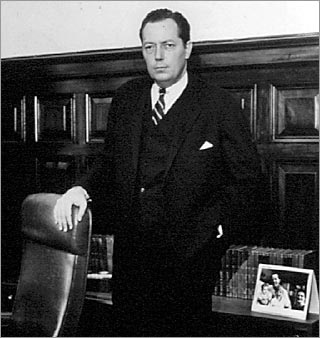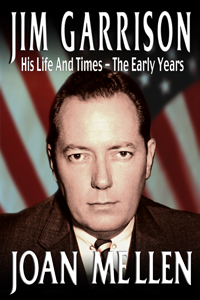A new biography of the former District Attorney of Orleans Parish, Louisiana from his 1922 birth in Iowa and service in World War II – he was among those assigned to Dachau Concentration Camp the day after its liberation – to his years confronting the corrupt politics of Louisiana.
Jim Garrison would become the only public official ever to bring anyone before the bar of justice for the assassination of President John F. Kennedy.
This is the story of the man who took on that task. It explores Garrison’s populist and democratic values, and how he attempted to reform the critical political system of New Orleans in the 1960s, particularly the abuses of B-drinking and other crimes rampant in the French Quarter.
“Jim Garrison: His Life and Times” explores with fresh new information political New Orleans of the fifties and sixties, rich in corruption, maneuvering on all sides, wit, the outrageous, and the courageous, (Jim Garrison was both).
This first biography of Jim Garrison, cradle to 1966, recreates
- His family background: he was a descendant of William Lloyd Garrison of whom some Garrisons did not approve. “I confess that I did not like very well to claim relationship with Lloyd Garrison of Massachusetts of Abolition renown…he was a talented man, but rather eccentric in his views with regard to the African race in America,” wrote Judge Thomas Garrison Stansberry.
- Jim Garrison was unique in New Orleans of the period of being a staunch opponent of segregation and an advocate of civil rights.
- Jim Garrison in the United States Army Air Force visited Dachau concentration camp the day after its liberation, and this biography chronicles the effect of this experience on Garrison for the remainder of his life.
- The hilarious chronicle of how Jim Garrison, a reformer, became district attorney as a result of television debates modeled after the Kennedy-Nixon debates.
- Garrison was a civil libertarian, a passionate defender of the first amendment. WHen the police seized James Baldwin’s “Another Country” from a New Orleans bookstore, Garrison refused to charge the bookstore owner and vigorously opposed this censorship. “I never think of consequences,” Garrison said as he followed his convictions, even when they violated received wisdom.
- The Bourbon Street raids: Quarter life c. 1962 and what Garrison as a new district attorney did to change it. The story of stripper Linda Brigette, her “indecent” act, why she was arrested, and how Garrison broke his rule that his office not involve itself in pardons, by helping Linda escape her 30 day jail sentence. The book exposes as well police corruption, and how Garrison tried to create an office that would approach crime without fear or favor. Best is the inside expose of the practices French Quarter clip joints of Jim Garrison’s day.
- The Dombrowski case: a look into the arrest of three civil rights activists in New Orleans who were accused of Communist influence in their helping Dr. Martin Luther King, Jr. and Garrison’s role as Orleans Parish district attorney.
- “Sacred Cows: why Jim Garrison was sued for criminal defamation by the judges of the Orleans Parish criminal court, the humorous trial, and the trajectory of this case, like the Dombrowski case, to the United States Supreme Court.
- Although this book only touches on the Garrison’s investigation into the Kennedy assassination, the foreword offers new details of the evidence that Lee Harvey Oswald was debriefed upon his return from the Soviet Union, a debriefing the CIA has always denied. An appendix re-examines the elusive figure of Jack Martin in the Kennedy case.
- The notorious case of Leonard Caesar, a rapist, who was stashed for years at the Louisiana State Prison (Angola) and the efforts by Garrison’s law school classmate, John R. Rarick, to offer him the opportunity to stand trial.
- Jim Garrison emerges as a defender of the victims of racial inequality, and of censorship. His actions reveal him to be a supporter of the defendant, and a fierce proponent of the rights of the individual. It also reveals him to have been, in many ways, a man of his generation.”The last perfect person walked the earth two thousand years ago,” Garrison once said.
- This volume takes us to the moment in 1966 when Jim Garrison began to investigate the Kennedy assassination.
Joan Mellen met New Orleans District Attorney Jim Garrison in 1969. His relentless search for the truth concerning President Kennedy’ assassination made a deep impression upon her. In 1997 Mellen began work on the story of Garrison’s life. This biographical project quickly focused on Garrison’s investigation and then initiated Mellen’s new investigation of the assassination itself. The preponderance of research material convinced Mellen to separate Garrison’s life and career on the pivotal case of the Kennedy assassination.
Her previous book, “A Farewell to Justice: Jim Garrison, JFK’s Assassination, and the Case That Should Have Changed History,” is the story of Garrison’s efforts to solve that historic murder. This prequel, “Jim Garrison: His Life and Times, The Early Years” depicts Garrison’s life up to that point. “JFK’s Assassination, and the Case That Should Have Changed History.”
Foreword to Jim Garrison: His Life and Times, The Early Years
In 1997, a decade ago, I began to write a biography of Jim Garrison. My goal was to tell the story of my subject from cradle to grave. Garrison would be studied, like my earlier biographical subjects, Kay Boyle, Lillian Hellman, and Dashiell Hammett, for his strengths as for his weaknesses. I would be aided by the fact that as I knew Boyle and Hellman, so I had been acquainted with Jim Garrison over a period of years, beginning in 1969.
I planned, of course, to devote a considerable portion of the book to Jim Garrison’s investigation into the Kennedy assassination, and to why this man, alone of all public officials to this day, was able to bring before the bar of justice someone involved in the plot to assassinate President Kennedy. As I drove up and down the roads of Louisiana, I realized that I had to write as well about my own investigation and examine whether the documents released under the JFK Act confirmed Jim Garrison’s findings or rendered them irrelevant.
After seven years, a book of 1500 or so pages emerged. The exigencies of publishing are grim, and Jim Garrison remained a figure attacked and discredited still, forty years after he began his investigation. Circumstances permitted only a book about Garrison’s Kennedy work. That was “A Farewell To Justice” (2005), for which I utilized about a third of the research I had done.
Since its publication, readers have asked me: what were Garrison’s motives? What kind of man was he? In the elliptical style of “A Farewell To Justice,” I could not convey the complexities of the man, or the contradictions in his character. Nor could I establish the extraordinary single-mindedness and purpose with which Jim Garrison approached his attempt to discover what had happened to the President whom he so much admired.
Had I been permitted to write the long book required to reveal Garrison’s life, I would have been able to consider whether the charges against him orchestrated by J. Edgar Hoover and others had any validity: Was Garrison soft on the Mafia? Was he on the take? Was he an egoist investigating the Kennedy assassination in pursuit of personal glory and fame? Was he careless and in violation of the law in his treatment of witnesses and suspects in the Kennedy case? Were suspects treated fairly and with equality by Garrison as District Attorney of Orleans Parish? What were Jim Garrison’s values and convictions, and in what ways, if he did, was he able to transcend his limitations?
 It was the idea of my publisher Debra Conway that I return to where I began, to the story of Jim Garrison’s life, and I am grateful to her. When I re-read the original manuscript, I discovered that I had written as much a history of New Orleans in the 1960s as I had a biography of Jim Garrison. Inevitably, hence the subtitle “life and times,” I had placed the man against the landscape of that steamy port of no return, where immigrants from the mid-west, like Garrison’s mother, reached the end of their search for sanctuary. Iowa-born Jim Garrison engaged with New Orleans, and with the state of Louisiana, recognizing that he had an advantage as an outsider. As Garrison himself pointed out, he owed no loyalty to the status quo.
It was the idea of my publisher Debra Conway that I return to where I began, to the story of Jim Garrison’s life, and I am grateful to her. When I re-read the original manuscript, I discovered that I had written as much a history of New Orleans in the 1960s as I had a biography of Jim Garrison. Inevitably, hence the subtitle “life and times,” I had placed the man against the landscape of that steamy port of no return, where immigrants from the mid-west, like Garrison’s mother, reached the end of their search for sanctuary. Iowa-born Jim Garrison engaged with New Orleans, and with the state of Louisiana, recognizing that he had an advantage as an outsider. As Garrison himself pointed out, he owed no loyalty to the status quo.
This volume takes the reader not to the end of Jim Garrison’s life, but to the moment when he declared that “nothing else matters” and devoted himself entirely to his Kennedy investigation. In the process, Garrison sacrificed a promising political career, a sacrifice he embraced with no regrets. Like a conventional biography, my book opens on Garrison’s family history and childhood and takes him through his formative years, not least his witnessing the atrocities of Dachau concentration camp at the close of World War Two. For Garrison, as he said later, this was a deeply influential moment. It holds an important place in what would be a life crowded with event. I close on Garrison in the fullness of his prime.
This book is not hagiography, the life of a saint. As Garrison remarked later in his life, the last perfect person walked the earth two thousand years ago. Rather, I hope I have chronicled the life of a person who was both a man of his time, a man of contradictions, and a man who rose above the ordinary. His passage is worthy of note.
JFK Lancer First Edition
Copyright © 2008 by Joan Mellen.
Printed in the United States
Cover design by Ken Jacobs
Book design by Debra Conway
ISBN Number 978-0-9774657-2-9
Over 300 pages
Perfect bound 6″x9″

